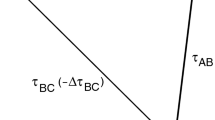Abstract
The determination of baseline lengths from certain space techniques is based on the derived coordinates of the terminal stations. As such, the estimated baselines are susceptible to systematic errors that affect the relative coordinates. One source of error is in the set of parameters which describes the continuously changing relative orientation of the Conventional Terrestrial (CTS) and Inertial (CIS) Reference frames. Due to these errors, the coordinates of each terminal station may in fact refer to a slightly different coordinate svstem, and, therefore, when used for computing the length between the stations, errors will result. The expected magnitudes of such errors and their possible presence in current solutions are investigated.
In conclusion, we find that the present level of accuracy and stability of the available parameters connecting the CTS and CIS (e.g., the ERP series) is unsatisfactory for centimeter level baseline length determinations. The available options are either the use of strictly simultaneous SLR data sets (similar to the VLBI data sets) or the improvement of the parameters connecting the CTS and the CIS. The first long-range step in the latter direction is the support of the IAG/IAU Joint Working Group COTES proposal [CSTG Bulletin, 1982], endorsed by both the IAG and IAU in various resolutions [IAU, 1983; IAG, 1982].
Similar content being viewed by others
References
D.C. CHRISTODOULIDIS and D.E. SMITH (1982): “SL5 Geodetic Solution,”Error Sources in SLR Baseline Determinations. NASA/Goddard Space Flight Center. Third Crustal Dynamics Working Group Meeting, Greenbelt, Maryland, October.
CSTG Bulletin (1982): “Reference Frame Requirements and the MERIT Campaign—Proposal for Extra Observations” June 9 (avail. Dept. of Geodetic Science and Surveying, Ohio State Univ., Columbus).
M. FEISSEL (1982): “Combined Estimates of the Earth Rotation Parameters—BIH Report,”Project MERIT, G.A. Wilkins and M. Feissel, eds., Royal Greenwich Observatory, Herstmonceaux, England.
IAG (1982): “Resolutions Adopted by the General Meeting of the International Association of Geodesy, Tokyo, May 7–10,”Bulletin Géodésique, 56, 4, 396–397.
IAU (1983): “The XVIIIth General Assembly of the International Astronomical Union, Patras, Greece, August, 1982, Resolution R5: The MERIT Campaign,”IAU Information Bulletin, 49, January, 1983, p. 9.
I.I. MUELLER, B.S. RAJAL and Y.S. ZHU (1982): “Comparison of Polar Motion Data from the 1980 Project MERIT Short Campaign,”High Precision Earth Rotation and Earth-Moon Dynamics, Proc. of IAU Colloq. 63, Grasse, France, May, 1981, O. Calame, ed., Reidel.
E.C. PAVLIS (1983): “On the Geodetic Applications of Simultaneous Range-Differencing to Lageos,” Dept. of Geodetic Science and Surveying Rep. 338, Ohio State Univ., Columbus.
Author information
Authors and Affiliations
Rights and permissions
About this article
Cite this article
Pavlis, E.C., Mueller, I.I. The effect of earth orientation errors in baseline determination. Bull. Geodesique 57, 273–282 (1983). https://doi.org/10.1007/BF02520933
Received:
Accepted:
Issue Date:
DOI: https://doi.org/10.1007/BF02520933




